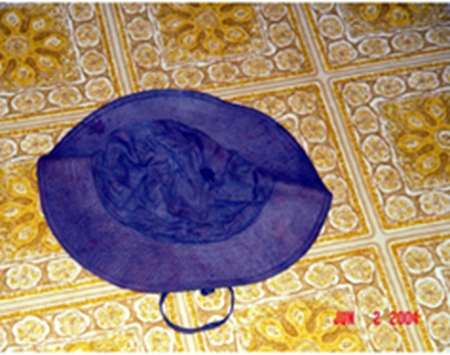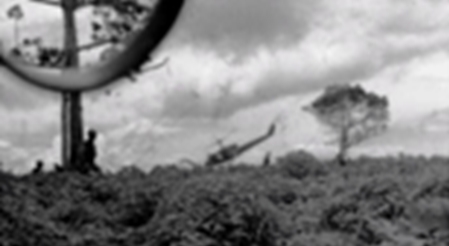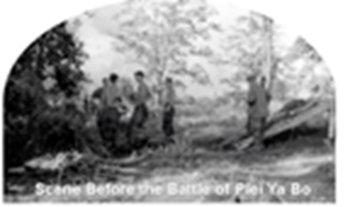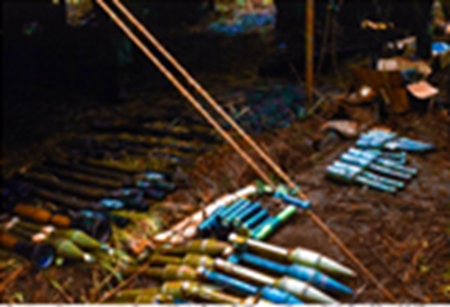You can listen to this post on Spotify. Please click on this link: https://open.spotify.com/episode/0R0ekYj4BX9FYm3fAbBxt6
My friend, Ken Ervin, was a skilled point man when serving with the Ivy Dragoons of the 4th Infantry Division. In this story, he relates a couple of unusual events that occurred while walking point on a mission. He also cites that his experience in recognizing an enemy trap prevented an ambush as befell his sister company a short distance away. In some units, squad leaders placed Cherries on point after only a couple of weeks in-country instead of using skilled and seasoned volunteers. How did your unit operate?
By Kenneth Ervin
I served in the 3rd Battalion/8th Infantry/4th Infantry Division which operated from the Ia Drang Valley westward through the mountains between Dak To and the Cambodian Border.
On this particular operation, Bravo and Charlie companies remained about 500 meters apart while conducting recon patrols through an old French Rubber Tree plantation in Plei Ya Bo; I was walking point and leading the 3rd Platoon of Bravo company. The plantation was located within the single canopy of the Ia Drang Valley in the Central Highlands and held many secrets. As the point man, my responsibility was to count steps while watching the ground cover to my front for booby traps and signs of the enemy. My bud, George Talton, was always my #2 man behind me. His job was to help me count our steps, keep me moving in the right direction, and to scan the trees for snipers. Our group was a closely-knit one as George, me, and several others in the platoon completed Basic and AIT training together and arrived in-country at the same time. We had the utmost trust in one another. A sudden thought popped into my head…
George had saved my life a couple days earlier, it was on July 23, 1967, when he suddenly called out for me to jump aside and then fired a buckshot round from his M79 grenade launcher over my right shoulder. When looking back, I spotted a humongous snake falling to the ground from a tree limb above. George spotted it seconds before he fired and said it was reaching for me – it’s mouth inches from my head. He always carried an M79 grenade launcher with a buckshot round loaded for close-up firing like he just demonstrated; the other rounds have to travel a short distance before arming the explosive. It was the biggest snake I ever saw. None of us were sure if it was poisonous or not, but it surely could have squeezed the life out of me. A few more rounds from my M16 assured us that it would no longer be a concern.

The photo above shows the terrain in our part of the Ia Drang Valley. It also shows me (l) and George (r) holding what we learned to be a giant Burmese Python
Back to the present: I suddenly spotted three NVA soldiers a short distance away, just standing there and sharing a cigarette. They hadn’t spotted me – I quickly aimed and fired on full automatic – emptying my 18-round magazine in seconds. They immediately dropped from sight and didn’t return fire. When we reached the area where they were last seen, we discovered a single body and blood trails leading away from that spot. The dead NVA soldier was somewhat stockier and taller than other NVA soldiers we’ve seen and guessed that he might be Chinese. We were further convinced after finding a German P38 Luger handgun and a rare Chinese hunting knife attached to his web gear.

Chinese Mandarin Symbol Engraving on the captured knife handle of a Chinese special operative

Soft Boonie hat was worn by the Chinese operative complete with his bloodstains
I took both of these items as well as his soft booney hat as war souvenirs. When we returned to the firebase, I gave the German Luger to my Company C.O., who we called Pineapple, because he was a Polynesian from Hawaii. He treasured the bounty and kept it throughout his tour. The other two items remained in my possession to this day.
We followed the two blood trails which led us to a bunker and tunnel complex. We destroyed the five bunkers, but had no idea how big the tunnel system was and who all were underground. We didn’t have a Tunnel Rat with us on this patrol and chose, instead, to throw in CS gas canisters in an attempt to flush them out. When that proved futile, we followed up with a few grenades which caused the entrance to collapse. This was all reported to higher-higher who informed us that another unit would follow-up and we were to continue our patrol through the area.
Periodically, the NVA used a trail watching tactic where they would show themselves to our point man and then run from us in hopes that we’d chase them right into a larger units ambush. (Something similar occurred in the movie, We Were Soldiers…, when an LT ordered his platoon to chase after a single soldier after landing in the Ia Drang Valley and then getting trapped). Today was July 25, 1967, and soon, we’d encounter the famous 32nd NVA Regiment.
It wasn’t long after leaving the enemy basecamp that the sound of a firefight erupted from the vicinity of Charlie Company. Our platoon reacted quickly, all dropping in place and forming a hasty perimeter. The LT had his ear to the radio handset and was monitoring the communications between the elements of Charlie Company and the battalion commander in his overhead chopper. It didn’t take long for the orders to come and tell us to move up and flank the enemy to the front of Charlie. The rest of the day and most of that night passed in a blur. I remember that for the most part, my platoon wasn’t involved in the battle as it continued to move away from us.
I do remember that our “Charlie Company” had a Platoon wiped out except for one member who was badly wounded and taken captive by the NVA; his name was Andrew York. The Battalion CO saw all the American bodies unmoving on the ground and spotted a large group of NVA soldiers moving away from them. The colonel called artillery fire on the retreating group and virtually destroyed them. Andrew’s legs were badly wounded and his hands bound with hemp rope. Over time, he was able to chew through the rope and crawl back to friendly lines. You can find his personal story on the author’s website, links are provided at the end of this article.

Huey Dustoff chopper retrieving our dead and wounded on 7/25/67

In the early morning hours of 7/25/67 prior to Charlie Company’s fight
My recollection of what happened next had faded over the years so I did some research to see if it would help me remember. I went back and read our Chargers “after-action Report” – shown below, in part. Sure enough, a single platoon of “C” company fell for the ruse and was massacred after being led into an ambush.
231150 July: 3rd platoon returning to the C Company CP from the south observed 2 NVAs to the platoons north vicinity coordinates YA 855190. The platoon immediately pursued while the company commander directed his 1st platoon to maneuver to a blocking position. At the same time, the 2nd platoon was returning to the company CP’s perimeter.
231155 July: The platoon leader of the 3rd platoon, C Company reported that his platoon was cut off and surrounded. The company commander ordered the 1st platoon to the relief of the 3rd platoon. However, the 1st platoon came under intensive small arms and mortar fire and was pinned down, precluding the directed relief. At this time the C company commander ordered his 2nd platoon, now some 800 meters s/w of the company perimeter to hold in place!
The battle continued for another six hours while the NVA retreated to the Cambodian border. There were tons of artillery rounds fired and hundreds of bombs dropped from supporting units to extricate Charlie company. Bravo Company was soon ordered to join in the fight; portions of that company found themselves fighting pitched battles to relieve Charlie company.
According to the reports, the 32nd NVA Regiment comprised of 1000 – 1200 soldiers. Americans confirmed 184 dead NVA corpses over the battlefield and an estimated 200 – 250 WIA enemy soldiers. 8 enemy soldiers surrendered and were taken prisoner. The totals show that the enemy regiment lost almost half of its effective troops in the battle.
Charlie company suffered 20 KIA, 22 WIA medivaced, and another 16 WIA who remained with the company and were treated on the battlefield. Bravo company sustained 1 KIA and 14 WIA during the battle. It should also be pointed out the Charlie company’s (CP) perimeter was also fighting pitched battles with the enemy as they attempted to overrun the Americans.

RPG7s that were made in Russia. They were left behind by the retreating NVA as they ran back to the safety of the Cambodian border region!
I keep thinking back to the day before when I fired on the three enemy soldiers. I know I surprised them and had they been more alert and spotted us first, I’m quite certain they would have high tailed it out of there – hoping that I’d take the bait. But I knew better and wouldn’t have given chase. What if a different squad was on point yesterday? Would they have given chase? What if the bunker complex was manned by enemy soldiers? Did my experience save members of my platoon or were they expecting me to keep them safe when I was on point? Nobody will ever know.
Uncle Ho trained his troops well and developed ingenious ways to kill, especially, Americans because of our habits. We were a curious bunch and picked up anything that seemed out of place or weird, we’d kick empty cans when coming upon them, and chase after fleeing troops. The enemy also knew that the soldier in front or behind the man carrying a radio was either an NCO or an officer – they were trained to go after them to cut the head from the snake. The enemy also knew to set-up ambushes after a B52 strike as Americans were bound to show up to assess the strike. Too many others to list here.
Kenneth Ervin maintains two blog sites where he also posts articles relating to the Vietnam War. I’d recommend a visit when you can. Here are the direct links:
https://kenervin50.wordpress.com/
http://kenervinnvietnam.blogspot.com/
If you are interested in reading the actual “After Action Report” for this battle, you’ll find it here:
Click to access AAR%2023%20July%2067.PDF
Thank you, Kenneth (bro) for allowing me to publish one of your many stories on my website. Thank you, too, for your service, sacrifice, and courage.
Thank you for taking the time to read this. Should you have a question or comment about this article, then scroll down to the comment section below to leave your response.
If you want to learn more about the Vietnam War and its Warriors, then subscribe to this blog and get notified by email or your feed reader every time a new story, picture, video or changes occur on this website – the button is located at the top right of this page.
I‘ve also created a poll to help identify my website audience – before leaving, can you please click HERE and choose the one item best describing you. Thank you in advance!



Great story! Anyone know how to reach Ken? My uncle served in this unit (3rd batt, 8th infantry, 4th division Ivy Dragoons) up until ’67. He died in the Phu Yen province in January of that year. I’d like to connect with anyone who knew him. His name was Frank Moss Rhodes. Thanks in advance. You can also email me at sir.distortion AT gmail.com
LikeLike
Great informative article. I was born in 1964 but remember some of what was going on then.
LikeLike
Thanks for your clear piece and your reasoned responses to the changing situation..
However, FYI, a Luger is often identified as “P 08” while a P-38 is a Walther pistol that looks completely different. both 9mm WWII German pistols.
LikeLike
Great story!! Some gung ho leaders are bound to cause KIA in their units. “Must be the first to kill or take a prisoner.” Let the seasoned NCO lead the way and if any questions ask!! Rely on a good point man and listen to the point!!
LikeLike
Aug ’70, our 1st Cav company got a new CO (West Point). His bright idea was to use “killer teams” (5 people, including an RTO and an M60 gunner) to walk trails, as bait, 100 meters ahead of the company. If/when, we were ambushed, we were to “hold” our position while the company moved to our “rescue” and flanked the enemy. Felt like the Christians in the Roman Coliseum, waiting for the lions.
LikeLike
Where can I find AAR’s, for particular periods, in VN? Specifically, “C” Co., 1st Bn, 7th Reg., 3rd Bgde, 1st Cavalry Division.
As for your story, well-written and reported. I did find the AAR’s somewhat of a typical Army routine – – lots of data and recommendations, yet, few, if any of the lessons learned were implemented. Your contact occurred, in July 1967, yet, when I got to my unit, in July 1969, albeit, a different division, there were no instructions on using foreign weapons, on carrying extra ammo on S&D ops, no practice of leaving claymores around company perimeter, when daytime patrols went out, just to name a few of the so-called “lessons learned” that were not implemented army-wide.
All the AAR’s accomplish is to have a record that some officer can write up and have it disappear into a file and is never read, again.
SNAFU and FUBAR…………
LikeLiked by 1 person
Ron, by mid-’69 the Army was FUBARed to the max, not just in combat units, but in combat support units as well. I was in combat aviation. We were getting troops from McNamara’s morons that were a danger to themselves and everyone else. And it wasn’t just the EM. We got new officers that couldn’t read a map, got pilots who came in and their flight records were stamped, “Cleared day copilot only”. Get these people to incorporate “lessons learned” into their daily routine? Forget it. It was a full time job just keeping them from killing us and themselves. Add to that the practice of “ticket punching” rotation of commanders and you have a receipt for disaster, which we often had. It’s a miracle that any of us survived.
Welcome Home.
LikeLike
Les, noted. Our platoon got an OCS 2nd Lt., in Nov. ’69, who lasted less than 2 months. He said he only went to OCS because he was told the war might be over before he graduated. Admitted he was a college dope-head, before being drafted. On one early patrol, he got us lost because he couldn’t read the map. The CO had to send a Loach to find us and lead us back to the company area. Lt. was gone, next log day. The 1st Cav Div had 6 month rotations, for officers, with our first 1Lt. (USMA grad) getting a silver star, for simply completing his short tour.
Thank you, for your sacrifice.
LikeLike
I went from Vietnam 7/68 to the Army’s Primary Helicopter School at Fort Wolters Texas as an instructor pilot. Our student attrition rate was in the 30-40% rate for either flight or academic reasons or both. At some point in 1969 our flight commander told us that pilot bodies were needed and nobody was to be failed unless that student pilot was just plain hopeless. FUBAR!
LikeLike
Good article.
LikeLiked by 1 person
Interesting how Russia and China supplies arms to N Vietnam. There appears to be few of their soldiers. Seems they did not want to get bogged down in this war the way the US did.
Was the fear the US politicians had valid in thinking they would become involved if we had advanced into N Vietnam?
LikeLiked by 1 person
I don’t believe anyone should be surprised that China & Russia supplied their ally and close neighbor, North Vietnam. Certainly, if the U.S. advanced into the north, Russia and particularly China may well have entered en mass.
LikeLike